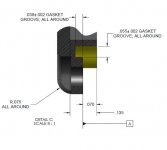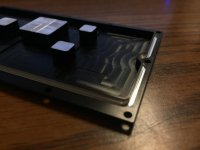Bigbore050
Aluminum
- Joined
- Apr 4, 2016
I having some trouble with machining some hard anodized aluminum and I’m looking for some opinions before I invest in more tooling.
Material: 6061-T6
Coating: Back hard anodize class 3 type 2
Current Tooling: Harvey Tool 942247-C8 3/64 square endmill 3x LOC 3 flute TiB2(Titanium Diboride) coated.
We use to machine these parts complete but the coater was having issues masking the parts so now we are cutting the masked features after anodize.
I need to machine a .055 wide .038 deep square groove next to a .07 high wall. I left .008 per side on the wall before anodize and machine it to size with a 1/8 endmill to remove the hard coat before the small cutter comes in to machine the groove. We started running the same speeds and feeds after anodize that we were running before anodize. 12,000 rpm and a feed of 17ipm ramping to depth at 1 degree and slotting full width at 17ipm. This netted us 150-250 parts per Endmill. Now with the hard coat we are only achieving 3 to 8 parts per Endmill. All of the breaks have happened after the ramping in when the cutter was in full cut. I’m afraid that the coating even only being .002 thick is dulling my edge increasing deflection and causing the break. I have been trying the find the broken end to see where my wear was but have not be able to find one yet. We have slowed the feed down to 5ipm and we are currently still running at 15 parts.
On our next run I will leave a step on the floor so the 1/8 Endmill will remove most of the hard coat on the floor and the wall prior to machining the groove but that won’t help me on the 250 pc. Batch I’m currently running.
I was looking at trying the same endmill with either an amorphous diamond(942247-C4) or CVD diamond coating(995747), but I have zero experience with tooling of this kind. I have some MA Fords coming from msc with .01 corner raduis 2 and 4 flute versions to try since I get them next day and my last endmill is in the machine. Going to place a order with Harvey today. Any suggestions would be greatly appreciated.


Material: 6061-T6
Coating: Back hard anodize class 3 type 2
Current Tooling: Harvey Tool 942247-C8 3/64 square endmill 3x LOC 3 flute TiB2(Titanium Diboride) coated.
We use to machine these parts complete but the coater was having issues masking the parts so now we are cutting the masked features after anodize.
I need to machine a .055 wide .038 deep square groove next to a .07 high wall. I left .008 per side on the wall before anodize and machine it to size with a 1/8 endmill to remove the hard coat before the small cutter comes in to machine the groove. We started running the same speeds and feeds after anodize that we were running before anodize. 12,000 rpm and a feed of 17ipm ramping to depth at 1 degree and slotting full width at 17ipm. This netted us 150-250 parts per Endmill. Now with the hard coat we are only achieving 3 to 8 parts per Endmill. All of the breaks have happened after the ramping in when the cutter was in full cut. I’m afraid that the coating even only being .002 thick is dulling my edge increasing deflection and causing the break. I have been trying the find the broken end to see where my wear was but have not be able to find one yet. We have slowed the feed down to 5ipm and we are currently still running at 15 parts.
On our next run I will leave a step on the floor so the 1/8 Endmill will remove most of the hard coat on the floor and the wall prior to machining the groove but that won’t help me on the 250 pc. Batch I’m currently running.
I was looking at trying the same endmill with either an amorphous diamond(942247-C4) or CVD diamond coating(995747), but I have zero experience with tooling of this kind. I have some MA Fords coming from msc with .01 corner raduis 2 and 4 flute versions to try since I get them next day and my last endmill is in the machine. Going to place a order with Harvey today. Any suggestions would be greatly appreciated.




